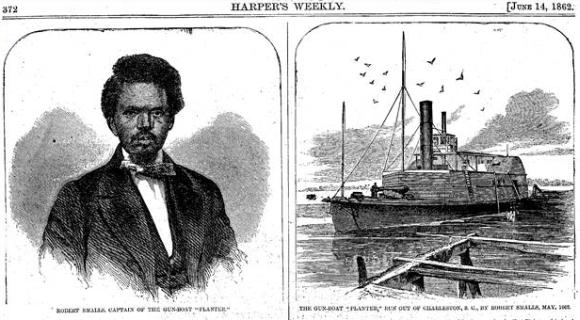 Two years ago, we posted about the the 150th anniversary of the seizure of the Confederate armed transport, CSS Planter, by Robert Smalls, a 23 year old mulatto slave, and eight fellow slaves. Smalls, who had served as the pilot of the transport, steamed it out past the batteries and forts of Charleston harbor and turned it over to the Union naval blockade. Smalls would go on to become the first black Captain of a U.S. Navy vessel, a South Carolina State Legislator, a Major General in the South Carolina Militia, a five-term U.S. Congressman and a U.S. Collector of Customs. This week archaeologists announced that they believe to have found the buried wreck of the Planter, off Cape Romainon the South Carolina coast, where the vessel later sank in 1876.
Two years ago, we posted about the the 150th anniversary of the seizure of the Confederate armed transport, CSS Planter, by Robert Smalls, a 23 year old mulatto slave, and eight fellow slaves. Smalls, who had served as the pilot of the transport, steamed it out past the batteries and forts of Charleston harbor and turned it over to the Union naval blockade. Smalls would go on to become the first black Captain of a U.S. Navy vessel, a South Carolina State Legislator, a Major General in the South Carolina Militia, a five-term U.S. Congressman and a U.S. Collector of Customs. This week archaeologists announced that they believe to have found the buried wreck of the Planter, off Cape Romainon the South Carolina coast, where the vessel later sank in 1876.
Ship taken by slaves 152 years ago found off South Carolina coast
“This story has had a lot of resonance, particularly in the Lowcountry communities, places where people still know Robert Smalls’ story,” said Bruce Terrell, senior archaeologist and maritime historian with NOAA’s Office of National Marine Sanctuaries.
Expeditions to find the Planter began in 2010 after research of historical documents showed that the ship grounded in a nor’easter in 1876 and sprang a bow plank while trying to salvage another grounded vessel.
The ship had offloaded its cotton near Georgetown, South Carolina, but passengers and crew were rescued from it by the crew of the nearby Cape Romain lighthouse, Terrell said.
Excavating the Planter is “up in the air,” he said, despite interest from museums in artifacts from the ship. Because it is buried, recovery would be expensive and excavation could disturb sensitive loggerhead sea turtle nesting grounds in the Cape Romain National Wildlife Refuge, Terrell said.
A plaque identifying “the last resting place of Robert Smalls’ Planter” was dedicated at the refuge’s education center on Tuesday.
